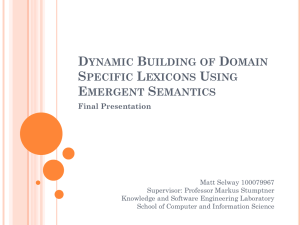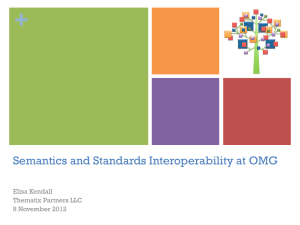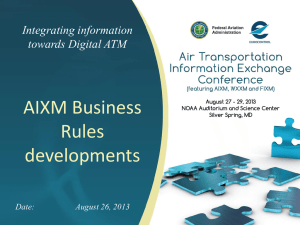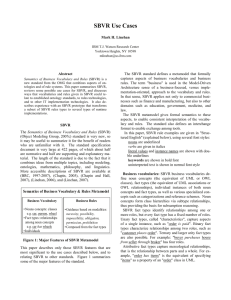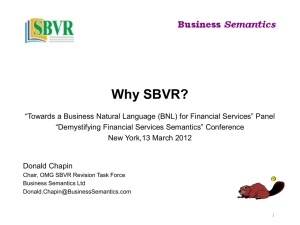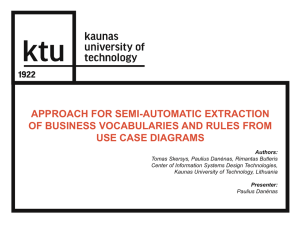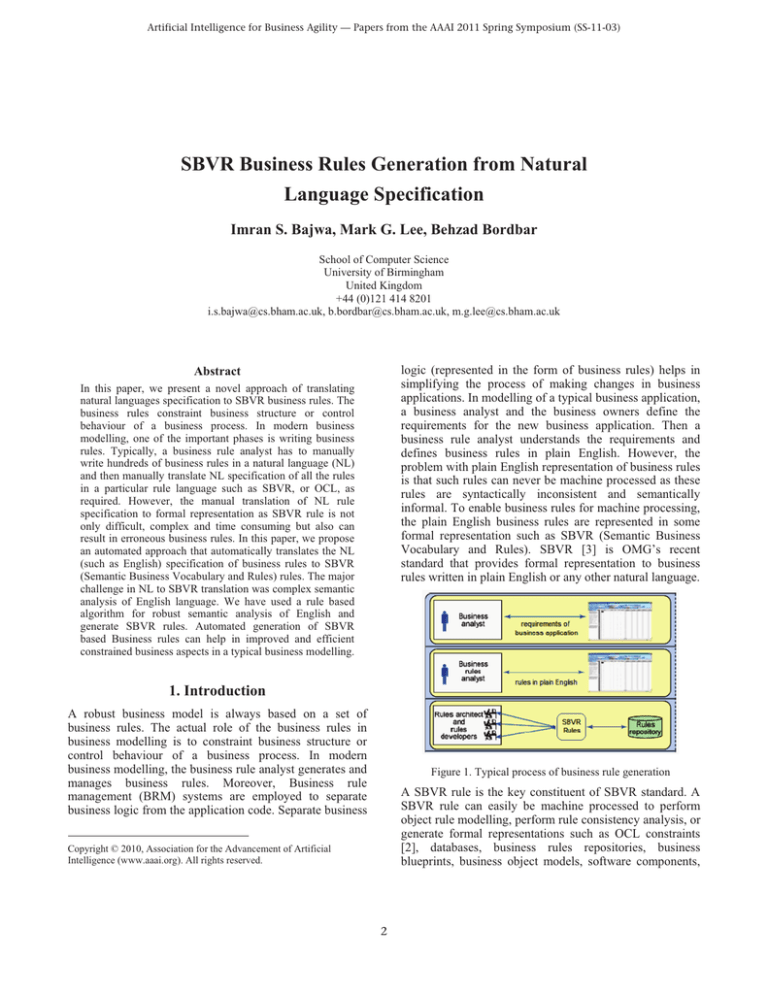
Artificial Intelligence for Business Agility — Papers from the AAAI 2011 Spring Symposium (SS-11-03)
SBVR Business Rules Generation from Natural
Language Specification
Imran S. Bajwa, Mark G. Lee, Behzad Bordbar
School of Computer Science
University of Birmingham
United Kingdom
+44 (0)121 414 8201
i.s.bajwa@cs.bham.ac.uk, b.bordbar@cs.bham.ac.uk, m.g.lee@cs.bham.ac.uk
logic (represented in the form of business rules) helps in
simplifying the process of making changes in business
applications. In modelling of a typical business application,
a business analyst and the business owners define the
requirements for the new business application. Then a
business rule analyst understands the requirements and
defines business rules in plain English. However, the
problem with plain English representation of business rules
is that such rules can never be machine processed as these
rules are syntactically inconsistent and semantically
informal. To enable business rules for machine processing,
the plain English business rules are represented in some
formal representation such as SBVR (Semantic Business
Vocabulary and Rules). SBVR [3] is OMG’s recent
standard that provides formal representation to business
rules written in plain English or any other natural language.
Abstract
In this paper, we present a novel approach of translating
natural languages specification to SBVR business rules. The
business rules constraint business structure or control
behaviour of a business process. In modern business
modelling, one of the important phases is writing business
rules. Typically, a business rule analyst has to manually
write hundreds of business rules in a natural language (NL)
and then manually translate NL specification of all the rules
in a particular rule language such as SBVR, or OCL, as
required. However, the manual translation of NL rule
specification to formal representation as SBVR rule is not
only difficult, complex and time consuming but also can
result in erroneous business rules. In this paper, we propose
an automated approach that automatically translates the NL
(such as English) specification of business rules to SBVR
(Semantic Business Vocabulary and Rules) rules. The major
challenge in NL to SBVR translation was complex semantic
analysis of English language. We have used a rule based
algorithm for robust semantic analysis of English and
generate SBVR rules. Automated generation of SBVR
based Business rules can help in improved and efficient
constrained business aspects in a typical business modelling.
1. Introduction
A robust business model is always based on a set of
business rules. The actual role of the business rules in
business modelling is to constraint business structure or
control behaviour of a business process. In modern
business modelling, the business rule analyst generates and
manages business rules. Moreover, Business rule
management (BRM) systems are employed to separate
business logic from the application code. Separate business
Figure 1. Typical process of business rule generation
A SBVR rule is the key constituent of SBVR standard. A
SBVR rule can easily be machine processed to perform
object rule modelling, perform rule consistency analysis, or
generate formal representations such as OCL constraints
[2], databases, business rules repositories, business
blueprints, business object models, software components,
Copyright © 2010, Association for the Advancement of Artificial
Intelligence (www.aaai.org). All rights reserved.
2
etc. A business rules always belong to a particular business
domain. In SBVR, the business domain is represented by
SBVR vocabulary [3] that is the second major constituent
of SBVR standard. In our approach, a UML class model
represents a business domain and we extract the business
vocabulary from the UML model. To create SBVR rules, a
business rule analyst has to manually translate business
rules (written in plain English) to SBVR syntax. But, the
manual translation of plain English business rules to SBVR
rules is not only complex but also difficult and time
consuming. Moreover, the manual effort to generate SBVR
rules from NL specification can result in erroneous rules.
The scenario becomes more complex in the absence of any
tool support for automated translation of plain English
business rules to SBVR rules.
In this paper, we present a novel approach NL2SBVR to
translate natural language (such as English) specification
of business rules to SBVR rules. A major challenge, in
accurate translation of English text to SBVR rules, was to
overcome the English’s inherent syntactic ambiguities and
semantic informalities. SBVR provides a set of logical
formulations [3] that can help in robust semantic analysis
of English language text. We have written an algorithm for
semantic analysis of English text that is based on SBVR’s
semantic formulation. This algorithm is used in our
approach to parse English text and extract SBVR syntactic
elements. Our approach extracts SBVR vocabulary from a
UML [1] class model. Afterwards, the SBVR elements are
mapped to SBVR vocabulary to ensure that the output
SBVR rules will be targeting a particular business domain.
Finally, the SBVR rule is generated from UML mapped
SBVR elements. Our approach NL2SBVR is implemented
in a tool ‘RuleGenerator’ as a proof of concept.
The rest of the paper is structured as follows: section 2
describes preliminary concepts related to SBVR; section 3
describes in detail the NL2SBVR approach; section 4
presents overview of the tool ‘RuleGenerator’ and also
shows the experimentation and results of the tool; section 5
discusses the evaluation methodology followed by a
discussion on the related work. The paper ends with a
conclusion section.
is a key term that represents a business entity in a
particular domain. There basic types of concepts [3] are
noun concepts, individual concept, and verb concepts.
Typically, the common nouns are classified as noun
concepts while the proper nouns or quantified nouns are
denoted as individual concepts. A verb concept can be an
auxiliary verb or action verb or both. However, a fact type
is a combination of a verb concept and noun concepts. A
Fact type specifies the relationship among different
concepts in a business rules.
In our research we use a UML class model as a business
domain. Hence, the business vocabulary comes from the
target UML class model. With respect to UML class
model: class names and their attributes names are
represented as noun concepts, object names are represented
as individual concepts, operation names are named as
action verbs, and the associations and generalizations are
represented as fact types.
Figure 2. A UML class model defining business domain
In example of figure 2, person, vehicle, car are noun
concepts. Similarly, the getName, getAge, getSalary are
verb concepts and association ownership is fact type in
SBVR.
II. Business Rules
Semantic Business Vocabulary and Rules (SBVR) [3] is an
adopted standard, introduced by OMG. By using SBVR,
informal specifications can be captured in natural
languages and represented in the formal logic so that they
can be machine-processed. SBVR allows the production of
business vocabulary, business facts and business rules in a
particular business domain. Brief description of the major
elements in SBVR is given below.
In SBVR, the business rules represent particular business
logic in a specific context. Each SBVR business rule is
based on at least one fact type. Business rules The SBVR
rules can be of two types [3]: definitional rules and
behavioral rules:
x Definitional Rules or structural rules are used to define
an organization’s setup [3] e.g. It is necessary that
each customer has at least one bank account.
x Behavioural Rules or operative rules express the
conduct of an entity [3] e.g. It is obligatory that each
customer can withdraw at most GBP 200 per day.
In perspective of UML class model, the definitional or
structural rules usually involve the attributes of the classes
and objects, while the Behavioural or operative rules
involve the operations, associations, and generalizations of
classes and objects.
I. Business Vocabulary
III. Semantic Formulation
Business vocabulary defines a particular business domain.
In SBVR 1.0, business vocabulary can have two major
types of elements [3]: Concepts and Fact Types. A concept
In SBVR, logical formulations are used to semantically
formulate the SBVR rules. The common logical
formulations are [3]:
2. Semantic Business Vocabulary and Rules
3
1.
2.
3.
4.
5.
Atomic formulation specifies a fact type in a rule
e.g. “customer should be old” is atomic
formulation from the fact type “customer is old”.
Instantiation formulation denotes an instance of a
class e.g. “silver account” is an Instantiation of
the noun concept “bank account”.
Logical operations e.g. conjunction, disjunction,
implication, negation, etc are also supported in
SBVR. In natural languages, the logical
operations allow combining NL phrases to create
more complex logical expression.
Quantification states the enumeration of a noun
concept or verb concept e.g. “at least one”, “at
most one”, “exactly one”, etc are used to quantify
concepts.
Modal Formulation identifies the meanings of a
logical formulation. e.g. “It is obligatory” or “It is
necessary” are used to formulate modality.
3.
4.
5.
and keep all the intermediate analyses result for
further analysis.
Use the results produced by NLP module to map
with the input UML model to make it sure that the
output SBVR rules are related to the target UML
model.
Use the UML model to extract the SBVR
vocabulary. Use the results produced by NLP
module to extract SBVR elements e.g. noun
concept, object type, Individual concept, verb
concept, etc.
Use the SBVR vocabulary & SBVR rule to
generate SBVR business rule.
IV. SBVR Notation
In SBVR 1.0 document [3], the Structured English is
proposed, in Annex C, as a possible notation for the SBVR
rules. The Structured English provides a standardized
representation to formalize the syntax of natural language
representation. In this paper, we have used the following
Structured English specification: The noun concepts are
underlined e.g. person; the verb concepts are italicized e.g.
should be; the SBVR keywords are bolded e.g. each, at
least, at most, obligatory, etc; the individual concepts are
double underlined e.g. white car or black bike.
Another available notion in SBVR standard 1.0 is
RuleSpeak. Our tool RuleGenerator supports both SBVR
notations.
Figure 3. The NL2SBVR Approach
Figure 3 illustrates the main steps of the NL2SBVR
approach. The working of the above defined steps has been
described in detail in the following section:
I. The Input Documents
The NL2SBVR approach takes two input documents: an
English text document (.txt file) and a UML class model
(.ecore file). The English text is taken as a plain text file
containing only English constraint. Current version of the
RuleGenerator handles only one English constraint at a
time. The given English text should be grammatically
correct. UML model is taken as ECORE or XMI format.
We used Eclipse UML2 Ecore Editor to create a UML
model and export it in XMI format.
3. NL to SBVR Translation
The NL2SBVR is a modular NL-based approach that
generates SBVR business rules from English text with
respect to a target Business domain. It takes two inputs: a
single English statement and a UML class model. Here
English statement is English specification of a business
rule and the UML class model provides a business domain.
To process the input English text first it is linguistically
analyzed. In linguistic analysis of the English text, the
English text is Parts-Of-Speech (POS) tagged. Then a rule
based parser [8] is used to further process the POS tagged
information to extract basic SBVR elements e.g. noun
concept, fact type, etc. Here, the SBVR vocabulary is
mapped to a SBVR rule. Finally, to generate an SBVR
business rules, the SBVR vocabulary is mapped to SBVR
elements using the rule-based approach [11]. These steps
can be summarized as follows.
1. Obtain a text document that is English description
of a constraint and a target UML model.
2. Use a NLP module to syntactically and
semantically analyse the informal constraint text
II. The NLP Module
The core of NL2SBVR approach is a NLP module that
consists of a number of processing units organized in a
pipelined architecture. This NLP module is highly robust
and is able to process complex English statements. The
NLP system is used to lexically and syntactically process
the English text and then perform semantic analysis to
identify basic SBVR elements. The core system processes
a text into three main processing stages:
a. Lexical Processing
The lexical processor comprises for sub-modules: a
tokenizer, a sentence splitter, POS tagger, and a
morphological analyzer. The input to lexical analyzer is a
plain text file containing English description of the target
4
SBVR business rule. The output is an array list that
contains tokens with their associated lexical information.
In array list, each sentence is separated by ‘.’. The lexical
processing steps are performed in the following sequence:
1. Tokenization: In first step, the input English text
is read and tokenized to identify the tokens e.g.
“A person should be 18 years old.” is tokenized as
[A] [person] [should] [be] [18] [years] [old] [.]
2. Sentence Splitting: The sentence splitter identifies
the margins of a sentence and each sentence is
separately stored.
3. Parts-of-Speech (POS) Tagging: In third step,
partsof- speech tagging is performed of given text
to identify the basic POS tags for input text. For
POS tagging, the Stanford POS tagger v3.0 [9]
has been used that can identify 44 POS tags.
4. Morphological Analysis: After performing the
POS tagging, morphological analysis was
performed for all nouns and verbs. The
morphological analysis is performed to separate
the suffixes possibly attached to the nouns and
verbs [10]. For example, a verb “purchased” is
analyzed as “purchase + ed” and similarly a noun
“employees” is analyzed as “employee + s”.
b. Syntactic Analysis
We have used an enhanced version of a rule-based parser
for the syntactic analysis of the input text used in [11]. The
text is syntactically analyzed and a parse tree is generated
for further semantic analysis. Figure 3 shows the generated
parse tree of the above example.
the English input that is preprocessed by the NLP module.
Following mapping rules are used to identify the SBVR
elements:
x All proper nouns are mapped to the individual
concepts
x All common nouns appearing in subject part are
mapped to the noun concepts or general concept.
x All common nouns appearing in object part are
mapped to object type.
x All action verbs are mapped to verb concepts.
x All auxiliary verbs and noun concepts are mapped to
the fact types.
x The adjectives and possessive nouns (i.e. ending in ’s
or coming after ‘of’) are mapped to the attributes.
All articles and cardinal numbers are mapped to
quantification. All these rules are applied to the English
text and the output is stored in an array list. Following
example highlights the proposition of basic SBVR
elements in a typical SBVR rule.
A
A
NN
person
POS NN
VB
VB
NN
CD
’s
must
be
18
years
age
years.
III. The UML Module
The UML module reads both ECORE and XMI format of a
UML class model generated from Eclipse. The UML
module extracts all classes, objects, and their respective
attributes, operations and associations and finally maps
them to SBVR vocabulary. Following section also
describes how the SBVR vocabulary is mapped to the
SBVR elements generated by NLP module.
a. Generating SBVR Vocabulary
The SBVR vocabulary is generated from the input UML
model. All the classes are mapped to noun concepts,
attributes of the classes are named as the individual
concepts, and all the class operations are named as verb
concepts. The associations and the generalizations are
mapped to the binary fact types. Binary fact types [14] are
typically composed of two noun concepts and a verb
concept. All these SBVR elements with their associated
types are stored and exported as an array list. The list of
SBVR vocabulary that consists of concepts and fact types
are used as a reference element during construction of
SBVR rules.
b. Mapping with UML Model
Before translation of English text to SBVR rules, the input
English text is mapped with the input UML model to
ensure that generated SBVR rules will be semantically
related to the target business domain. The mapping is
carried out in SBVR elements and SBVR vocabulary. The
noun concepts in SBVR rules are mapped to the UML
NP
VB
18
Figure 5. Semantic analysis of English text
VP
NP
DT
must be
Quantification Noun Attribute Verb Quantification Noun
Concept
Concept
Concept
S
NP
person ’s age
Figure 4. Parsing English text using dependency grammar
c. Semantic Analysis
In this semantic analysis phase, role labeling [12] is
performed. The desired role labels are actor, co-actor,
action, thematic object, and a beneficiary if exists. These
roles will assist in identifying different SBVR elements in
the next phase and also be used in constructing fact types
from the extracted SBVR elements. In semantic analysis
phase, after role labeling, the order is identified in which
subject, verb, object, and adverb appears in the input
English text. The output of the NLP module is an xml file
that contains the parsed English text with all the extracted
information.
Basic SBVR elements e.g. Noun concept, individual
concept, object type, verb concepts, etc are identified from
5
classes. Individual nouns are mapped to the UML objects.
Verb concepts are mapped to methods of a class.
Adjectives and possession nouns (with of and ‘s) are
tagged as attributes. A fact types are mapped with the
associations and generalizations. If the mapping is carried
out then the output of the module is sent forward to the
SBVR module otherwise the user is notified that business
(English) rule is not related to the business domain (UML
model). For example, if user gives following English text:
A person’s nationality should be British.
In this example, nationality attribute is not available in
person class, so SBVR rule for this English input will not
be generated.
quantification. These quantifications guide in
identifying the cardinality of a noun concept.
7. Modal Formulation: Modal formulation [3] is
used to specify meanings of the other logical
formulations. A set of mapping rules based on
modal verbs e.g. can, may, should, etc are defined
to identify the four basic types of modal
formulations. For example the modal verbs “can”
or “could” are mapped to possibility formulation.
Similarly, modal verb “should” or verb concept
“have to” is mapped obligation formulation.
b. Applying SBVR Notation
The last step in SBVR rule generation is to apply a SBVR
notation. RuleGenerator supports both SBVR notations:
SBVR Structured English and RuleSpeak. To apply
Structured English the noun concepts are underlined e.g.
person; the verb concepts are italicized e.g. can have; the
keywords are bolded i.e. SBVR keywords e.g. each, at
least, at most, obligatory, etc; the individual concepts are
double underlined e.g. black car.
It is obligatory that a person’s age should be at least 18
years.
IV. The SBVR Module
The SBVR module is based on a rule based parser that
contains set of rules to map SBVR elements with SBVR
vocabulary and generate complete SBVR rules. In this
phase detailed semantic analysis of the English text is
performed. Following section describes how the SBVR
rules are generated.
a. Generating SBVR Rule
SBVR rules are generated from the output of the NLP
module. To generate SBVR rules, the first step is to create
a fact type. A fact type is created by mapping the noun
concepts and verb concepts to the fact types available in
the SBVR vocabulary array list. Atomic formulization is
used to map the input text to a suitable target fact type in
SBVR vocabulary. The mapped fact type is used to
generate a SBVR rule by applying a set of logical
formulations. As For the different types of syntactic
structures used in English language, respective types of
logical formulations have been defined. Following are the
details that how we have incorporated these logical
formulations to map English language text into SBVR rule.
5. Logical Operations: The logical operations [3] are
used to combine one or more expressions, known
as logical operand to produce complex Boolean
expressions. The logical expressions e.g. AND,
OR, NOT, implies, etc are incorporated using
logical formulations. To apply logical operations a
set of rules were defined that help to identify the
number and names of operands and the operator
from the input English text. For example, the
tokens “not” or “no” are mapped to negation.
Similarly, the tokens like “and” are mapped to
conjunction and “or” is mapped to disjunction,
etc.
6. Quantification: Quantification [3] is a logical
formulation that uses a variable to specify the
scope of a concept. The basic types of
quantifications were identified by using a set of
rules i.e. the tokes like “more than” or “greater
than” are mapped to at least n quantification.
Similarly, the token “less than” is mapped to at
most n quantification and the token “equal to” or a
positive statement is mapped to exactly n
The SBVR produces a SBVR rule in the form of text string
that is further formatted using the SBVR notation i.e.
Structured English described in the section 2.4. The output
SBVR module is saved and exported in two separate files:
an xml file contains the SBVR vocabulary; a text file
contains the formatted SBVR rule.
4. Experiments and Results
To find the bugs in the working of the tool experiments
were performed to carry out the dynamic verification of the
software tool. To test the accuracy of the SBVR rules
generated by the designed system three classes were
defined: invariants, preconditions and post-conditions.
Various complexity levels of input i.e. simple, compound
and complex SBVR rules were also defined to verify the
consistency of tool’s output. All rule types can be
structural or behavioural. Both, the simple and complex
rules contain only one fact type. Moreover, the simple
rules do not involve association and generalizations but
complex business rules involve associations and
generalizations. Compound rules are complex rules with
multiple fact types. Examples of defined complexity levels
are following:
Simple: A person’s age should be more than 18 years.
Complex: A vehicle’s colour can be white or black.
Compound: If a person’s salary is more than 10,000$
then the person can buy a car with white colour.
To test tools accuracy, 10 examples of each complexity
level were used. Constraint types for each 10 examples
were generated. Each generated SBVR business rule from
each category was type-checked. To verify syntax of BVR
rules, SBeVeaR tool was used that is an SBVR type
checking tool. For the sake of type checking in SBeVeaR,
6
the used class model and the generated SBVR business
rule were given as input.
behavioural rules. The accuracy of various SBVR rule
types is analyzed against simple, complex and compound
input English statements. The correctness of the software
tool was verified though static verification by performing
the described analysis.
Figure 6. English input
Figure 9: Evaluating results
Figure 7. SBVR vocabulary generated from UML model
5. RELATED WORK
Applications of NLP in the field of software and business
modelling are really significant especially to improve
accuracy, productivity, flexibility, multilinguality and
robustness [13]. Hector presented a semi-natural language
(4WL) to automatically generate object models from
natural language text [14]. LOLITA is another Natural
Language Processing System that was used to extract
object oriented information from the NL text [15]. K. Li
addressed NLP problems in object oriented analysis
(OOA) [16]. NOESIS (Natural Language Oriented
Engineering System for Interactive Specifications) is a
WordNet based NL text analysis module [17]. A tool
REBUILDER based on NOISES is introduced by Gomes
(2004) to generate class diagrams from NL specification. A
significant contribution by Harmain and Gaizauskas was
their NL based CASE tool named CM-Builder [18]. All
these tools motivate for design of a tool that can assist
users in creating business rules from English.
Extraction of semantic knowledge from NL specification
and its transformation to ER models was performed by
Omar [19]. Semantic heuristics were used to extract the
relevant ER elements such as entities, attributes, and
relationships from the specifications. E-R Generator [20] is
another rule-based designed tool that performs semi
automatic generation of E-R Models from NL
specifications. Similar to this work NLP has also been used
for conceptual modeling [21]. Natural languages have also
been mapped to java code [11].
A controlled natural language (CNL) is a subset of a
natural language with restricted grammar and vocabulary
[22]. Controlled grammar and vocabulary minimizes
ambiguity and complexity involved in processing of
natural languages. Controlled natural languages are useful
in reliable automatic semantic analysis of the language
[23]. A particular challenge for natural language
processing is the translation of NL to formal semantics. In
Figure 8. SBVR rule generated from English input
The above shown screenshots are from our tool
RuleGenerator that gets a UML Model and English
representation as input. The tool works as first of all, a
XMI file is read as input for the target UML class model.
All the classes and associations in given UML class model
are used to generate the SBVR vocabulary. Then, the input
English text is syntactically and semantically analyzed to
create a SBVR rule after mapping with SBVR vocabulary.
Table 1: Evaluating results
Complexity level/
Constraint Type
Structural
Rules
Behavioural
Rules
Total
Simple
87.3%
91.5%
91.63%
Complex
86.2%
90.2%
89.73%
Compound
85.7%
84.8%
83.74%
Average accuracy: 87.33%
A matrix representing SBVR business rules accuracy test
(%) for invariants, preconditions, and post conditions has
been constructed. Overall accuracy for all types of SBVR
business rules is determined by adding total accuracy of all
categories and calculating its average that is 87.33%.
The following graph is showing the accuracy ratio of
various SBVR rule types in terms of structural and
7
recent times, SBVR has been presented as a language for
the semantic formalization of natural languages [24].
[10] Ilieva M., Olga O. 2005. Automatic Transition of Natural
Language Software requirements Specification into Formal
Presentation. Springer LNCS Vol. 3513, pp.392--397 (2005)
[11] Bajwa I., Samad A., Mumtaz S. 2009. Object Oriented
Software modeling Using NLP based Knowledge Extraction,
European Journal of Scientific Research, 35(01), p.22-33
6. CONCLUSION
In business modelling, business logic is easy to express in
natural languages but the business logic expressed in
natural langauge is usually not semantically formal and
unambiguous. This research paper presents a novel
approach that automatically translates natural language
specification of business rules to SBVR business rules. The
presented approach is also implemented in a tool
‘RuleGenerator’ as a proof of concept. RuleGenerator can
find out the noun concepts, individual concepts, verbs and
adjectives from the NL text. This extracted information is
further incorporated to constitute a complete SBVR rule.
The presented approach is fully automated. The presented
approach not only assists the business rule analysts and
architects by generating precise SBVR rules from NL
specification in a simple and quick manner. As a next step,
we are hoping to investigate usability aspects of the tool
directly via empirical methods involving teams of
developers.
[12] Bryant B., et al. 2008. From Natural Language Requirements
to Executable Models of Software Components. In Workshop on
S. E. for Embedded Systems pp.51-58
[13] Leidner, J. L. (2003). Current issues in software engineering
for Natural Language Processing. HLT-NAACL 2003 Workshop
on Software Engineering and Architecture of Language
Technology Systems – Vol. 8 (May 31 - 31, 2003), Morristown,
NJ. p.45-50.
[14] Perez-Gonzalez, H. G., Kalita J. K. (2002). Automatically
Generating Object Models from Natural Language Analysis.17th
Annual ACM SIGPLAN conference, OOP, Systems, languages &
applications. p.86-87.
[15] Mich, L. (1996). NL-OOPS: from natural language to object
oriented requirements using the natural language processing
system LOLITA. Natural Language Engineering. 2(2) p.167-181.
[16] Li, K., Dewar R. G., Pooley R. J. (2004). Object-Oriented
Analysis Using Natural Language Processing. Heriot-Watt
University
Technical
Reports.
www.macs.hw.ac.uk:8080/techreps/docs/files/HW MACS-TR0033.pdf
REFERENCES
[1] OMG. 2007. Unified Modeling Language (UML), OMG
Standard, v. 2.3.
[17] Seco, N., Gomes P., Pereira F.C. (2004). Using CBR
for Semantic Analysis of Software Specifications. Advances in
Case-Based Reasoning. LNCS Vol. 3155/2004 p.41-43.
[2] Bajwa I.S., Behzad Bordbar, Mark G. Lee, (2010), OCL
Constraints Generation from NL Text, IEEE International EDOC
conference 2010, Vitoria, Brazil
[18] Harmain, H. M., Gaizauskas R. (2003). CM-Builder: A
Natural Language-Based CASE Tool for Object- Oriented
Analysis. Automated Software Engineering. 10(2) p.157-181.
[3] OMG. 2008. Semantics of Business vocabulary and Rules
(SBVR), OMG Standard, v. 1.0.
[19] Omar, N., Hanna P., Kevitt P. (2006). Semantic Analysis in
the Automation of ER Modelling through Natural Language
Processing. International Conference Computing & Informatics,
June 2006. pp.1-5.
[4] Engels G., Heckel R., K¨uster J. 2001. Rule-Based
Specification of Behavioral Consistency Based on the UML
Meta-model, LNCS Vol. 2185, pages 272-287
[5] Linehan M. 2008. Ontologies and rules in Business Models.
11th IEEE EDOC Conference Workshop, pp. 149-156,
[20] Gomez, F., Segami C., Delaune C. (1999). A system for the
semiautomatic generation of E-R Models from Natural Language
Specifications. Data and Knowledge Engineering 29 (1) p.57-81
[6] Linehan M. 2008. SBVR Use Cases. International Symposium
on Rule Representation, Interchange and Reasoning on the web,
RuleML, LNCS Vol.5321 pp.
[21] Al-Safadi, L.A.E. (2009). Natural Language Processing for
Conceptual Modeling. International Journal of Digital Content
Technology and its Applications. 3 (3).
182-196
[7] Cabot J., et al. 2009. UML/OCL to SBVR Specification: A
challenging Transformation, Journal of Information systems
doi:10.1016/j.is.2008.12.002
[22] Hart, G., Johnson M., Dolbear C. (2008). Rabbit: Developing
a Control Natural Language for Authoring Ontologies. 5th
European Semantic Web Conference (ESWC'08). 348-360.
[8] Bajwa, I. S., Choudhary M.A. 2006. A Rule Based Paradigm
for Speech Language Context Understanding. International
Journal of Donghua University (English Edition). 23, 06 (June
2006), 39-42.
[23] Spreeuwenburg, S., Healy K. A. (2009). SBVR’s Approach
to Controlled Natural Language. Workshop on Controlled Natural
Language 2009, Marettimo Island, Italy Available:
http://sunsite.informatik.rwthaachen.de/ publications/ CEURWS/Vol-448/paper26.pdf
[9] Toutanova. K., Manning, C.D. 2000. Enriching the
Knowledge Sources Used in a Maximum Entropy Part-of-Speech
Tagger. In the Joint SIGDAT Conference on Empirical Methods
in Natural Language Processing and Very Large Corpora. 63-70.
Hong Kong.
[24] Kleiner, M., Albert P., Bézivin J. (2009). Parsing SBVRBased Controlled Languages. Model Driven Engineering
Languages and Systems 2009. LNCS Vol. 5795/2009 p.122-136.
[25] SBeaVer, http://sbeaver.sourceforge.net/
8



